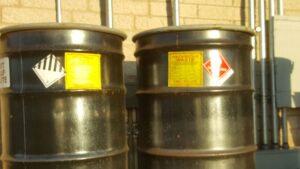Federal regulations of the U.S. Environmental Protection Agency (USEPA) mandate a small quantity generator of hazardous waste (SQG) take certain precautions to prepare for and prevent hazardous waste emergencies and to follow emergency procedures if one were to occur. These regulations are found within the SQG conditions of exemption at 40 CFR 262.16:
- 40 CFR 262.16(b)(8) Preparedness and prevention
- 40 CFR 262.16(b)(9) Emergency procedures
This article is the fourth in a series that closely examines these regulations and attempts to make them understandable.
The previous article in this series addressed 40 CFR 262.16(b)(8)(iii) Testing and maintenance of equipment
The purpose of this article is to address the requirements of 40 CFR 262.16(b)(8)(iv) Access to communications or alarm systems.
Before we begin…
These regulations were revised by the Generator Improvements Rule. If your state has not yet adopted the new rule you must continue to comply with the earlier version until it does. You may read an article explaining the earlier version of the regulations (prior to implementation of the Generator Improvements Rule) here.
 After your state adopts the Generator Improvements Rule, it may choose to make its version of these regulations more stringent and more broad than these Federal regulations. The actions of your state will vary based on whether or not it has an authorized hazardous waste program. Be sure to check the regulations of your state to ensure compliance.
After your state adopts the Generator Improvements Rule, it may choose to make its version of these regulations more stringent and more broad than these Federal regulations. The actions of your state will vary based on whether or not it has an authorized hazardous waste program. Be sure to check the regulations of your state to ensure compliance.
Scope and Applicability:
These regulations are applicable to a SQG. The requirements of a large quantity generator of hazardous waste (LQG) are almost exactly the same. If you are a LQG please refer to this article for your version of these regulations: Emergency Preparedness and Prevention for Large Quantity Generator: Access to Communications or Alarm Systems.
Not sure of your hazardous waste generator status? |
As explained in an earlier article of this series, these regulations solely apply to those areas of a SQG where hazardous waste is:
- Generated, i.e., the point of generation.
- Accumulated, i.e., central accumulation area and satellite accumulation area.
- Areas where allowable treatment takes place
- Areas where hazardous wastes are stored prior to off site transportation.
40 CFR 262.16(b)(8)(iv) reads:
(iv) Access to communications or alarm system. (A) Whenever hazardous waste is being poured, mixed, spread, or otherwise handled, all personnel involved in the operation must have immediate access (e.g., direct or unimpeded access) to an internal alarm or emergency communication device, either directly or through visual or voice contact with another employee, unless such a device is not required under paragraph (a)(8)(ii) of this section.
(B) In the event there is just one employee on the premises while the facility is operating, the employee must have immediate access (e.g., direct or unimpeded access) to a device, such as a telephone (immediately available at the scene of operation) or a hand-held two-way radio, capable of summoning external emergency assistance, unless such a device is not required under paragraph (a)(8)(ii) of this section.
What changed?
Not much. And everything. USEPA revised the existing regulations to include the parenthetical “(e.g., direct or unimpeded access)” after “immediate access” in both paragraphs (a) and (b). The reason? USEPA felt the term “immediate access” was not clearly understood by the regulated community and additional clarification was required.
Let’s take a closer look at the wording, terms, and phrases used in §262.16(b)(8)(iv):
First, paragraph (a):
“Whenever hazardous waste…” This refers to the activities that trigger the need for access to communications or alarm system. Subject activities include any time hazardous waste is being:
- Poured
- Mixed
- Spread
- Otherwise handled
It does not include on site accumulation if none of the above activities are taking place. However, the term “otherwise handled” is vague enough to include a lot of activities not specified here.
“…all personnel involved…” Anyone involved in a subject activity indicated above would be a person who must have initial and annual recurrent Hazardous Waste Personnel Training. It does not apply to person who may be nearby the subject activity but not “involved in the operation”. It will include contractors or others that are not employees of the SQG.
Like this article? Subscribe to my Monthly Newsletter No marketing emails! |
“…must have immediate access (e.g., direct or unimpeded access)…” The big change to this section. It’s purpose was to clarify what USEPA means by “immediate access”. Unfortunately, the words themselves are subjective and not further defined by USEPA. Common definitions for both terms are:
di·rect
/dəˈrekt,dīˈrekt/
1. extending or moving from one place to another by the shortest way without changing direction or stopping.
2. without intervening factors or intermediaries.
adverb: with no one or nothing in between.
And…
un·im·ped·ed
/ˌənəmˈpēdəd/
not obstructed or hindered.
Clearly USEPA intends for a SQG to make access to its internal alarm(s) or emergency communication device(s) as “immediate” to its hazardous waste personnel as it is able to do safely.
Contact me with any questions you may have about the generation, identification, management, and disposal of hazardous waste Daniels Training Services, Inc. 815.821.1550 |
“…to an internal alarm or emergency communication device…” This is the same as the “internal communications or alarm system” included with required equipment at §262.16(b)(8)(ii). It does not specify what the internal alarm or emergency communication device is, nor how it is used.
“…either directly…” This text provides two options for the personnel involved in the operation to have immediate access to the internal alarm or emergency communication device:
- Directly. i.e., the personnel involved in the operation walk to and operate themselves.
- Through visual or voice contact with another employee. i.e., the personnel involved in the operation signal to another employee by visual or voice to indicate a need to activate the internal alarm or emergency communication device.
“…unless such a device…” Here again is a reference to §262.16(b)(8)(ii) Required equipment. It allows the SQG to determine for itself if the hazards posed by its hazardous waste require an internal alarm or communication device, or if there is a better location for it other than the point of operation.
Taken together the intent of paragraph (a) of this section is to ensure hazardous waste personnel involved in activities that may result in a fire, explosion, or release of hazardous waste have immediate access to an internal alarm or communications device.
Contact me the next time hazardous waste generator USEPA training is due to expire. |
Second, paragraph (b):
“…just one employee on the premises…” The first sentence of this paragraph creates a situation of limited scope. To be applicable, both of the following must be true:
- Just one employee on the premises at the SQG.
- Facility is operating.
Unlike paragraph (a) of section §262.16(b)(8)(iv), paragraph (b) does not limit its applicability solely to hazardous waste personnel or to activities directly related to hazardous waste. Any employee finding themselves alone at a SQG while it is in operation will be subject to paragraph (b).
Like paragraph (a), paragraph (b) contains language open to interpretation, without clarification “…on the premises…”? “…while the facility is operating…”? A common definition for premises:
prem·is·es
/ˈpreməsəz/
a house or building, together with its land and outbuildings, occupied by a business or considered in an official context.
Q: By “operating” does USEPA mean only those times when the SQG is open for business?
A: Uncertain. USEPA’s interpretation of “while the facility is operating” is not stated clearly within the context of the preparedness, prevention, and emergency procedures regulations. Elsewhere, USEPA regulations and guidance on when a SQG is operating is vague and/or contradictory. (RO 13063 v. Introduction to Tanks [EPA/530/k-05/018, September 2005]). I recommend you consider any time hazardous waste to be generated or accumulated at a SQG to be “while the facility is operating” (e.g., weekends and holidays) unless you have written confirmation from USEPA or your state that indicates otherwise.
“…must have immediate access…” The same modification was made to this text as it was in paragraph (a): “(e.g., direct or unimpeded access)” was added after “immediate access”. This revision has the same function here as it does in paragraph (a): to ensure a communication device is immediately accessible to a person who may have need of one in an emergency.
Interested in a Webinar that covers this topic, and more! |
“…to a device…” Paragraph (b) does not require immediate access to an internal alarm as does paragraph (a). In this potential situation, the one employee on the premises has no need of an internal alarm or communication system. Their sole requirement is a device capable of summoning assistance from outside the facility. The communication device may be either of the following but is not limited solely to these:
- A telephone if immediately available at the scene of operation. This – I think – refers to an area where hazardous waste is generated, accumulated, or otherwise handled.
- Hand-held two-way radio capable of summoning external emergency assistance.
“…capable of summoning…” As noted previously, the intent of paragraph (b) is that a person on their own at a SQG will be able to summon external emergency assistance if necessary.
“…unless such a device…” Here again is a reference to §262.16(b)(8)(ii) Required equipment. It allows the SQG to determine for itself if the hazards posed by its hazardous waste require a device capable of summoning external emergency assistance, or if there is a better location for it other than the point of operation.
The intent of paragraph (b) of this section is to ensure a person alone on the premises of a SQG has immediate access to a device that can be used to call for external assistance.
Q: Does access to a cell phone satisfy the requirement for immediate access to an alarm or communication device?
A: No. USEPA believes that, although cell phones are a useful means of communication, they should not be relied upon solely to satisfy this requirement. (81 FR 85791)
A little more about access to communications or alarm systems:
The purpose of these regulations is to ensure that those emergency communication and alarm systems specified in §262.16(b)(8)(ii) Required equipment are accessible to the facility personnel who may have need of them in an emergency.
- Paragraphs (a) & (b) of §262.16(b)(8)(iv) apply to two different situations and each specifies its own requirements for that situation.
- Paragraph (a) applies to all personnel involved in hazardous waste management activities and requires immediate access to an internal communication or alarm system. It does not refer to external emergency communication.
- Paragraph (b) refers to a situation where just one employee is on the premises while the facility is operating; it doesn’t specify the activity the employee may be engaged in (it may not be related to hazardous waste management). And it doesn’t require internal communication; instead it mandates a device capable of summoning external emergency assistance.
- The regulations of this section do not apply to all of the emergency equipment identified in §262.16(b)(8)(ii), only those required for communication:
| Required Equipment Subject to §262.16(b)(8)(ii) | Immediate Access Required Subject to §262.16(b)(8)(iv) |
| Internal communication or alarm system | Immediate access required |
| Device capable of summoning emergency assistance | Immediate access required |
| Portable fire extinguishers & fire control equipment | Immediate access not required |
| Decontamination equipment | Immediate access not required |
Is that it?
No. There are still the remainder of the emergency preparedness and prevention regulations for a SQG in §262.16(b)(8). Also, there are the SQG emergency procedures of §262.16(b)(9). And, right in the midst of the SQG emergency procedure regulations is where we will find the training requirements for a SQG at §262.16(b)(9)(iii).

The next article in this series: 40 CFR 262.16(b)(8)(v) Required aisle space

